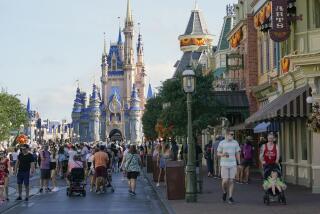Disney’s Japan Venture Loses Some Luster : Theme park: Attendance falls 2% in past year at Tokyo Disneyland, but families are still pouring into the popular attraction.
- Share via
TOKYO — After 10 years, a little of the magic dust may be wearing off Tokyo Disneyland. The theme park, with its blue castle spires rising from a landfill by Tokyo Bay, is beginning to feel the pinch of Japan’s recession.
But by any measure, it has been a success of wish-upon-a-star dimensions. Since opening on April 15, 1983, the park has drawn almost 125 million visitors--a number equal to the population of Japan.
It’s a pop-culture icon, beloved beyond all reason by many Japanese, the symbol of a recreational revolution in a work-obsessed nation.
Building the park was a $1.4-billion gamble for its Japanese owner, Oriental Land Co., a consortium that put up the capital to launch the project under a licensing arrangement with Walt Disney Productions.
Many predicted failure. Instead, the company paid off its huge debt after only three years.
It’s a tale worthy of Cinderella--or maybe of Tom Sawyer, as told by 13-year-old Musami Iwasa from Osaka.
“Sawyer-san, I think he married a princess and became very wealthy,” she said earnestly as she waited to board the Mark Twain riverboat in the park’s “Westernland.”
For visiting foreigners, that sort of skewed Americana gives the 115-acre park, built as a replica of the original Disneyland in Anaheim, a certain goofy charm.
“It’s definitely a little weird,” said Donald Nelson, 23, of Los Angeles. “It’s Japan, but it’s like its own planet.”
Though 95% of the visitors are Japanese, there are few concessions to Japanese culture. A restaurant serves tempura and sushi, and Mickey and Minnie Mouse don kimonos for New Year’s festivities.
When the park opened, Disney characters had been wildly popular here for decades, giving it a ready-made market. The late Emperor Hirohito visited California’s Disneyland in 1975 and afterward sported a Mickey Mouse watch on occasion.
Much of Tokyo Disneyland’s success may be a matter of timing. It opened just as a “leisure boom” was taking hold, and the Japanese attacked with single-minded zeal the new national duty of having fun.
There’s also the factor of the Japanese “cult of cute,” a seemingly limitless enthusiasm for the cuddly and adorable. Wide-eyed cartoon characters abound in Japanese advertisements, and public-address announcements often feature squeaky, childish female voices.
At Tokyo Disneyland, patrons’ birdlike cries of “Kawaii, kawaii!”--”Cute, cute!”--echo like part of a permanent soundtrack.
The park is an especially notable success compared to the other overseas Disney venture, Euro Disneyland, which opened outside Paris in 1992. The French venture has had lower-than-hoped-for attendance and a chilly reception from critics, one of whom called it a “cultural Chernobyl.”
Until a year ago, Tokyo Disneyland’s sales and attendance figures had risen steadily. But for the fiscal year that ended March 31, the number of visitors fell by 2% to 15.8 million, a slump that Hiroshi Sayama of the park’s publicity department attributed to the recession.
Even if the Disney boom has peaked, the daily tide of families pouring into the park testifies to its enduring popularity. It’s only six miles from downtown Tokyo.
“I think about 45,000 today--it’s a little slow,” said Sayama, dodging a small boy making for the main gate.
Repeat visitors come from all over Japan with the fervor of the faithful on a pilgrimage.
“How many times here? Eight--no, nine,” said 15-year-old Yuka Endo, perched on a bench with three friends, sporting Mickey ears and munching popcorn. “Maybe more.”
Admission prices are steep: $40 for adults, $37 for ages 12 to 17, $28 for children. The average guest spends $74 for a day’s outing, including food and merchandise, park officials say.
That’s a hefty tab for a family, but even in tough times many will scrimp elsewhere to indulge the children.
“Yes, it’s a little expensive,” said Katsuhide Okabe, 31, of Nagoya, who visits three times a year with his wife and two children. “But it’s worth it.”
The park is firmly ensconced in the Japanese cultural landscape, despite its American origins. On a recent spring day, Mieko Sano visited with her daughter, who was about to move to the United States with her husband and children.
“It’s a special occasion,” she said. “Maybe it’s the best way for them to remember the real Japan.”
More to Read
Inside the business of entertainment
The Wide Shot brings you news, analysis and insights on everything from streaming wars to production — and what it all means for the future.
You may occasionally receive promotional content from the Los Angeles Times.










